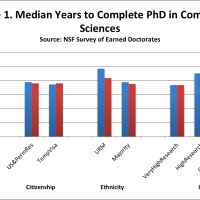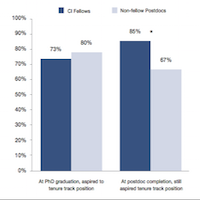Highlights of the CISE Fiscal Year 2015 Budget Request
On March 4, President Obama delivered his Fiscal Year (FY) 2015 Budget Request to Congress, and the President’s FY 2015 Budget Request for NSF was presented on March 11. At $7.3 billion, this Request supports investments in fundamental research across all scientific disciplines, engineering, and education that continue to enhance our national economy, security, and quality of life. This represents an increase of $83 million, or about 1.2 percent, over the FY 2014 NSF Estimate. For more information, see: http://www.nsf.gov/about/budget/fy2015/index.jsp.
I am pleased to let you know that the FY 2015 Budget Request for NSF includes $893.35 million for the CISE directorate, which is level with the FY 2014 Estimate and above the FY 2013 Actual investment by about $35 million. The CISE FY 2015 Request is shaped by investments in core research, education, and infrastructure programs, as well as investments in a crosscutting portfolio that aligns closely with national priorities and societal challenges.
In addition to the FY 2015 Budget Request, the President has put forward the Opportunity, Growth, and Security Initiative (OGSI), which provides an additional $552 million for NSF to spur economic progress, promote opportunity, and strengthen national security. This Initiative will accelerate progress in broad areas of science and engineering that address clearly defined national priorities, such as cybersecurity, neuroscience, clean energy, advanced manufacturing, and STEM workforce development.
I wish to emphasize four specific investment areas: expansions of CISE foundational research; crosscutting investments led by CISE; advanced cyberinfrastructure; and education and workforce development. To view a presentation on the CISE FY 2015 Priorities and Budget Request, see: http://www.nsf.gov/events/event_summ.jsp?cntn_id=130742&org=CISE.
Expansions of CISE Foundational Research: CISE remains strongly committed to its core programs in all areas of computer and information science and engineering. CISE will continue to cast a wide net and let the best ideas surface across its core programs in all four divisions and across investment levels, from single-investigator research to center-scale activities. For example, CISE continues its support for early-career researchers through increased investments in the CAREER program and maintains its investments in Expeditions in Computing , a center-scale program that promises to accelerate discovery at the frontiers of computing, communication, and information science and engineering. CISE is expanding its investments in foundational research, infrastructure, and education for Big Data science and engineering programs (e.g., see the Critical Techniques and Technologies for Advancing Big Data Science & Engineering solicitation posted on March 12). CISE is also maintaining its investments in Exploiting Parallelism and Scalability (XPS) , which supports the development of new foundational principles and cross-layer approaches.
Crosscutting Investments led by CISE: CISE leads a number of cross-cutting programs, which catalyze foundational research and, in many cases, cross over multiple directorates and agencies. In partnership with the Directorates for Engineering (ENG); Education and Human Resources (EHR); Mathematical and Physical Sciences (MPS); and Social, Behavioral and Economic Sciences (SBE), CISE continues to lead the Secure and Trustworthy Cyberspace (SaTC) program. SaTC will invest in game-changing research, develop scientific foundations, maximize research impact, and accelerate transitions to practice, and will address education and workforce issues. SaTC will fund a diverse set of collaborative projects in areas of current critical importance, such as mobile and cloud security, cybereconomics, science of security, and privacy in today’s networked world.
CISE leads the National Robotics Initiative (NRI) in partnership with ENG, EHR, and SBE, and with several other agencies, including the National Aeronautics and Space Administration (NASA), National Institutes of Health (NIH), and U.S. Department of Agriculture (USDA). The goal is to develop the next generation of collaborative robots that promise to enhance personal safety, health, and productivity. In partnership with NIH, Smart and Connected Health brings together six NIH institutes with three NSF directorates (CISE, ENG, and SBE) in an effort to accelerate the development and use of innovative approaches that would support the much-needed transformation of healthcare from reactive and hospital-centered to preventive, proactive, evidence-based, person-centered and focused on well-being. Furthermore, CISE is an active participant in the Brain Research through Advancing Innovative Neurotechnologies (BRAIN) initiative, a joint effort among the NSF, NIH, Defense Advanced Research Projects Agency (DARPA), and private partners with the goal of accelerating the understanding of brain structure and function.
The Cyber-Physical Systems (CPS) program, funded jointly with ENG, aims to continue our long-term investment in the foundational research enabling smart systems that sense, respond, and adapt to the environment. In a new partnership with the Department of Homeland Security (DHS) and Department of Transportation (DoT), CPS will support interdisciplinary research and education to further the understanding of fundamentals arising from grand challenge applications, such as advanced manufacturing, smart grid technologies, medical devices, and transportation networks. As smart systems become ubiquitous in our everyday lives and grow increasingly interdependent and complex every year, CISE, ENG and SBE have started a new program, Resilient Interdependent Infrastructure Processes and Systems (RIPS) , to ensure the reliability, resiliency, safety, and security of critical infrastructures.
Through agency-wide programs, such as Innovation Corps (I-Corps), CISE will continue to foster public-private partnerships to accelerate and improve the transfer of results of NSF-funded research to the commercial marketplace.
Advanced Cyberinfrastructure: Cyberinfrastructure has increasingly become a critical component of the R&D ecosystem. Realizing the enormous potential of cyberinfrastructure requires a long-term, bold, sustainable, and comprehensive approach. The NSF FY 2015 Budget Request includes significant support for advanced computational infrastructure, including Blue Waters, Stampede, and XSEDE. These are complemented by investments in several programs — Data Infrastructure Building Blocks (DIBBs) , Software Infrastructure for Sustained Innovation (SI2), and Computational and Data-Intensive Science and Engineering (CDS&E) – that together aim to catalyze new thinking, paradigms, and practices in developing and using data, software, and computational infrastructure to accelerate scientific discovery and engineering innovation.
NSF continues to make significant investments in experimental and prototype research and education networks that extend from the campus to international connections, including Campus Cyberinfrastructure – Infrastructure, Innovation and Engineering (CC*IIE) , International Research Network Connections (IRNC) , and CISE Research Infrastructure: Mid-Scale Infrastructure – NSFCloud .
Education and Workforce Development: In FY 2015, CISE reaffirms its commitment to education and workforce programs, including Graduate Research Fellowships and the NSF Research Traineeship (NRT) program, which promotes innovative, effective, and scalable models for STEM graduate student training, preparing scientists and engineers of the future. Related to these efforts, CISE and EHR will lead the foundation in its goal of increasing the Nation’s capacity in data science by investing in the development of human capital and infrastructure.
In collaboration with EHR, ENG, and SBE, CISE is continuing its research program, Cyberlearning and Future Learning Technologies , which promises to integrate advances in technology with advances in what is known about how people learn with a particular focus on cyberlearning and online education. This is an important area of inter-disciplinary exploration with enormous potential to transform formal and informal education.
CISE continues its focus on STEM-C Partnerships (building on important results from the Computing Education for the 21st Century, CE21, program) in order to increase the pool of students and teachers who develop and practice computational and data competencies in a variety of contexts and to increase the number and diversity of students who pursue degrees in computing, computation, and data-intensive fields.
As a field of inquiry, computer and information science and engineering has a rich intellectual agenda. Foundational research seeds new programs that keep our community at the frontiers of knowledge and discovery. I invite you to work with us to ensure that our Nation remains at the forefront of advances in science and engineering research, education, and cyberinfrastructure.









